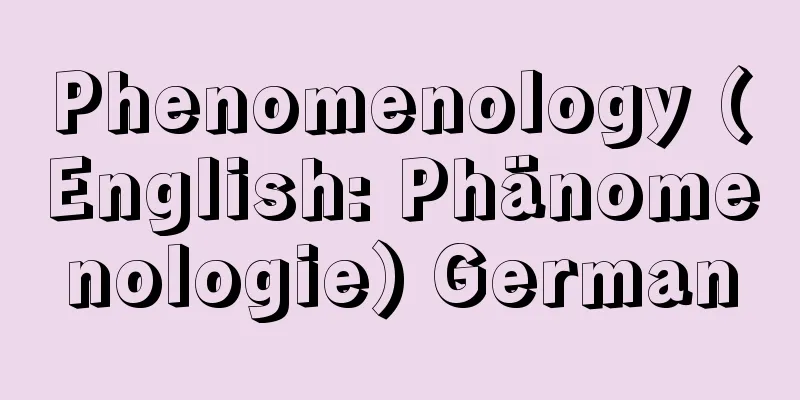Phenomenology (English: Phänomenologie) German

|
It is the study of the revealing of phenomena. However, depending on how the phenomena are understood, phenomenology has various meanings. The first philosopher to use the term phenomenology was Lambert, who meant the theory of illusion. Kant named the fourth part of "Metaphysical Foundations of the Natural Sciences," which treats movement as an external phenomenon, phenomenology. It was Hegel who gave phenomenology its definitive meaning. "Phenomenology of Spirit" describes the experience of consciousness from sensory certainty to absolute knowledge. However, what is referred to today as phenomenology is the phenomenology that began with Husserl. Husserl did not inherit the term phenomenology from Kant or Hegel. In the natural sciences and psychology of the time, phenomenology was spoken of as a criticism of conceptual constructions that were far removed from intuition, but it is thought that Husserl named his own philosophy phenomenology as a thorough implementation of such phenomenological methods. [Ryoichi Hosokawa] Husserlian phenomenologyHusserl's phenomenology began with Logical Investigations. In its first volume (1900), Logical Investigations criticized psychologism, which tries to base logic on psychology, by distinguishing between real (real) mental acts and ideal (ideal) thought contents. Nevertheless, mental acts are related to ideal thought contents. Therefore, the second volume (1901) of Logical Investigations was devoted to this correlation, in which the fundamental concepts of intuition (especially categorical intuition) as intentionality and meaning-fulfillment were developed. In the first volume of Thoughts for Pure Phenomenology and Phenomenological Philosophy (Ideas I, 1913), Husserl developed the descriptive phenomenology of Logical Investigations into constructive and transcendental phenomenology. Husserl places the general proposition "There is a world and I am in the world," which is the essence of the natural attitude, outside of action, and performs an epoché (suspension of judgment). This is a phenomenological reduction, which results in a realm of unquestionable pure consciousness. There, the correlation between noesis and noema (intentional action and intentional correlate) is extracted, and constructive phenomenology becomes possible based on this correlation. Ideas II, conceived following Ideas I, is a development of constructive phenomenology in line with territorial ontology (the natural world, the vital world, and the spiritual world). Husserl's phenomenology is an exploration of the world-constitution and self-constitution in transcendental subjectivity, and if phenomenology is systematically and completely developed, it will become a true universal ontology. In The Crisis of the European Sciences and Transcendental Phenomenology, written in his later years, he emphasizes the return from the scientific world to the lifeworld that had been concealed by objective science, but he also argues that we must return from the lifeworld to transcendental subjectivity. Husserl's phenomenology has consistently been a phenomenology of transcendental subjectivity. [Ryoichi Hosokawa] The development of phenomenologyThe Annals of Philosophical and Phenomenological Research (1913-30) were published with Husserl at the center, and became a clear expression of the phenomenological movement that began with Husserl. Ideas I was published in the first volume of the Annals. The Annals also published Scheler's major work Formalism in Ethics and Substantial Value Ethics and Heidegger's major work Being and Time. Scheler was influenced by Husserl's theory of intuition of essence, and claimed that a priori substantial values are intuited by emotions. Substantial value ethics was developed as a hierarchy of values: comfort value-life value-spiritual value-sacred value. In this way, Scheler attempted to go beyond the foundations of Kantian ethics as formalism. Heidegger conceived his own phenomenology by developing the theories of intentionality, categorical intuition, and a priori in Husserl's phenomenology. Being and Time was established through the critical absorption of Husserl's phenomenology and the critical inheritance of Greek philosophy, especially Aristotle's ontology. In Being and Time, philosophy is phenomenological ontology, which is made possible by the insight that Dasein understands being from time. Heidegger consciously placed phenomenology within the tradition of Western philosophy. Phenomenology was developed in France by Sartre and Merleau-Ponty. Sartre published excellent papers on imagination and emotion based on the intentionality of consciousness. Sartre's major work Being and Nothingness, subtitled "An Attempt at Phenomenological Ontology," was conceived in a confrontation with the analysis of Dasein in Being and Time. However, Sartre only understood Being and Time as existentialism. Influenced by the later Husserl, Merleau-Ponty understood phenomenology as a return to the lived world. Phenomenology of Perception critically transcends Gestalt psychology to perform a phenomenological analysis of the lived world and the body as the subject of perception. Phenomenology, as a movement in modern philosophy, has had a great influence on existential philosophy and even on the sciences. With the publication of the Collected Works of Husserl and the Collected Works of Heidegger, phenomenology has been reexamined and has undergone new developments, and it has become easier to engage in dialogue between phenomenology and other philosophies. [Ryoichi Hosokawa] Heidegger, translated by Hosoya Sadao, Hegel's Concept of Experience (1963, Risosha) ▽ Merleau-Ponty, translated by Takeuchi Yoshiro, Ogi Sadataka, Kida Gen, et al., Phenomenology of Perception (1967, 1974, Misuzu Shobo) ▽ Husserl, translated by Tatematsu Hirotaka, Studies in Logic, 4 volumes (1968-1976, Misuzu Shobo) ▽ Husserl, translated by Ikegami Kamazo, Pure Phenomenology and the Invention of Phenomenological Philosophy (Iwanami Bunko) ▽ Husserl, translated by Hosoya Tsuneo, The Crisis of European Academics and Transcendental Phenomenology (included in 51 World Masterpieces, 1970, Chuokoron-Shinsha) ▽ Tsujimura Koichi et al., eds., The Complete Works of Heidegger, 102 volumes (1985-, Sobunsha) ▽ Kida Gen, Phenomenology (Iwanami Shinsho) [References] | | | | |Source: Shogakukan Encyclopedia Nipponica About Encyclopedia Nipponica Information | Legend |
|
現象を開示する学をいう。しかし現象をどう理解するかによって、現象学はさまざまな意味をもつ。現象学ということばを用いた最初の哲学者はランベルトであり、仮象論の意味であった。カントは『自然科学の形而上(けいじじょう)学的基礎』において、運動を外官の現象として扱う第四部を現象学と名づけた。現象学に決定的な意味を与えたのはヘーゲルである。『精神の現象学』は、感覚的確信から絶対知へ至る意識の経験を叙述している。しかし今日現象学といわれているのは、フッサールに始まる現象学のことである。フッサールは現象学ということばをカント、ヘーゲルから継承したのではない。当時の自然科学、心理学において、直観とかけ離れた概念構成に対する批判として現象学が語られていたが、そうした現象学的方法を徹底するものとして、フッサールは自らの哲学を現象学と名づけたと考えられる。 [細川亮一] フッサール現象学フッサールの現象学は『論理学研究』によって開始された。『論理学研究』はその第1巻(1900)において、レアール(実在的)な心的作用とイデアール(理念的)な思惟(しい)内容とを区別することによって、心理学で論理学を基礎づけようとする心理主義を批判した。にもかかわらず、心的作用はイデアールな思惟内容と関係している。それゆえ『論理学研究』第2巻(1901)はこの相関関係を主題とし、そこで志向性、意味充実としての直観(とくにカテゴリー的直観)という現象学にとって基本的な概念が展開された。フッサールは『純粋現象学と現象学的哲学のための諸考想』第1巻(『イデーンⅠ』1913)において、『論理学研究』での記述的現象学を構成的、超越論的現象学へと発展させた。フッサールは、自然的態度の本質である「世界があり、私がその世界のうちにある」という一般定立を作用の外に置き、エポケー(判断中止)を行う。それは現象学的還元であり、そのことによって不可疑な純粋意識の領域が得られる。そこにおいてノエシス―ノエマ(志向的作用―志向的相関者)の相関関係が取り出され、この相関関係に基づいて構成的現象学が可能となる。『イデーンⅠ』に続いて構想された『イデーンⅡ』は、領域的存在論(自然的世界、生命的世界、精神的世界)に即した構成的現象学の展開である。フッサール現象学は、超越論的主観性における世界構成と自己構成の探究であり、現象学が体系的に完全に展開されれば、真の普遍的存在論となる。晩年の『ヨーロッパ諸科学の危機と超越論的現象学』において、科学的世界から、客観的科学によって隠蔽(いんぺい)されていた生活世界への還帰が強調されるが、しかしさらに生活世界から超越論的主観性へと還帰しなければならないとする。フッサール現象学は一貫して超越論的主観性の現象学であった。 [細川亮一] 現象学の展開フッサールを中心に『哲学および現象学的研究年報』(1913~30)が刊行され、それはフッサールに始まる現象学運動の明確な表現となった。『イデーンⅠ』は『年報』第1巻に掲載された。『年報』にはさらにシェラーの主著『倫理学における形式主義と実質的価値倫理学』、ハイデッガーの主著『存在と時間』が発表された。シェラーはフッサールの本質直観の説に影響を受け、感情によってア・プリオリな実質的価値が直観されることを主張した。実質的価値倫理学は、快適価値―生命価値―精神的価値―聖価値という価値の序列として展開された。そのことによってシェラーは、形式主義としてのカント倫理学をその根底から乗り越えようとした。ハイデッガーは、フッサール現象学における志向性、カテゴリー的直観、ア・プリオリの説を発展させることによって、独自の現象学を構想した。『存在と時間』は、フッサール現象学の批判的摂取と、ギリシア哲学、とくにアリストテレスの存在論の批判的継承によって成立した。『存在と時間』において、哲学は現象学的存在論であり、それは現存在が時間から存在を了解しているという洞察によって可能となった。ハイデッガーにおいて現象学は自覚的に西欧哲学の伝統のうちに置かれたのである。 フランスにおいて現象学を展開したのはサルトルとメルロ・ポンティである。サルトルは意識の志向性に基づき、想像や情緒に関する優れた論文を発表した。「現象学的存在論の試み」という副題をもつサルトルの主著『存在と無』は、『存在と時間』における現存在の分析論との対決のうちで構想された。しかしサルトルは『存在と時間』を実存主義として理解しているにすぎない。メルロ・ポンティは後期フッサールの影響のもとで、現象学を、生きられた世界への還帰としてとらえた。『知覚の現象学』はゲシュタルト心理学を批判的に乗り越えることによって、生きられた世界、知覚の主体としての身体を現象学的に分析している。 現象学は現代哲学の一つの運動として、実存哲学、さらに諸科学に大きな影響を与えた。『フッサール全集』『ハイデッガー全集』の刊行により、現象学の再検討とその新たな展開がみられ、さらには現象学と他の哲学との対話が容易となっている。 [細川亮一] 『ハイデッガー著、細谷貞雄訳『ヘーゲルの「経験」概念』(1963・理想社)』▽『メルロ・ポンティ著、竹内芳郎・小木貞孝・木田元他訳『知覚の現象学』(1967、74・みすず書房)』▽『フッサール著、立松弘孝訳『論理学研究』全4巻(1968~76・みすず書房)』▽『フッサール著、池上鎌三訳『純粋現象学及現象学的哲学考案』(岩波文庫)』▽『フッサール著、細谷恒夫訳「ヨーロッパの学問の危機と先験的現象学」(『世界の名著51』所収・1970・中央公論社)』▽『辻村公一他編『ハイデッガー全集』全102巻(1985~ ・創文社)』▽『木田元著『現象学』(岩波新書)』 [参照項目] | | | | |出典 小学館 日本大百科全書(ニッポニカ)日本大百科全書(ニッポニカ)について 情報 | 凡例 |
>>: Restoration to original state - Genjo kaifuku
Recommend
Kawatabi [Hot Spring] - Kawatabi
This hot spring is located in Naruko-cho, Tamazuku...
Nonae
…The standard days are the three days of the cale...
Natsudomari Peninsula
A peninsula jutting out into Mutsu Bay in central...
Agency for Cultural Affairs
An external bureau of the Ministry of Education, ...
Euphorbia milii (English spelling) Euphorbiamilii
… [Hiroshi Yuasa]. … *Some of the terminology tha...
Coastal zone (lakes and marshes)
… [Lake creatures] Because lakes and ponds are se...
Oonogawa River
It originates near Mt. Sobo (Miyazaki side) which...
Omu [town] - Omu
A town in the northern part of Hokkaido, Monbetsu ...
Maori - Maori
Maori is a Polynesian language spoken by the Maori...
Nouveau Concert (English)
…His marriage to a wealthy woman was a blessing i...
Binomial series - nikōkyūsū (English spelling) binomial series
For real number α ≠ 0 and integer n ≧ 0, we define...
Bukavu - Bukabu (English spelling)
It is the capital of South Kivu Province in the e...
Giovanni Pico della Mirandola
1463‐94 Along with Ficino, he was one of the leadi...
Diabolo
...In Europe, the Chinese drum was popular from t...
Płock (English spelling)
A city in the Masovian Voivodeship in central Pol...






![Shintotsukawa [town] - Shintotsukawa](/upload/images/67cbed4a15ba4.webp)


